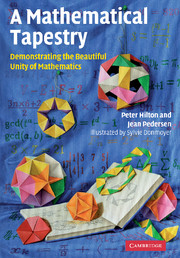
-
Select format
-
- Publisher:
- Cambridge University Press
- Publication date:
- November 2010
- July 2010
- ISBN:
- 9780511777004
- 9780521764100
- 9780521128216
- Dimensions:
- (247 x 174 mm)
- Weight & Pages:
- 0.76kg, 308 Pages
- Dimensions:
- (247 x 174 mm)
- Weight & Pages:
- 0.62kg, 306 Pages
- Subjects:
- Mathematics (general), Mathematics
You may already have access via personal or institutional login- Subjects:
- Mathematics (general), Mathematics
Book description
This easy-to-read 2010 book demonstrates how a simple geometric idea reveals fascinating connections and results in number theory, the mathematics of polyhedra, combinatorial geometry, and group theory. Using a systematic paper-folding procedure it is possible to construct a regular polygon with any number of sides. This remarkable algorithm has led to interesting proofs of certain results in number theory, has been used to answer combinatorial questions involving partitions of space, and has enabled the authors to obtain the formula for the volume of a regular tetrahedron in around three steps, using nothing more complicated than basic arithmetic and the most elementary plane geometry. All of these ideas, and more, reveal the beauty of mathematics and the interconnectedness of its various branches. Detailed instructions, including clear illustrations, enable the reader to gain hands-on experience constructing these models and to discover for themselves the patterns and relationships they unearth.
Awards
A Choice Outstanding Academic Title, 2011
Reviews
'For some 30 years Peter Hilton and Jean Pedersen have written papers and books on mathematics, both recreational and advanced. Now they have pulled it all together in one exciting and handsome volume. It opens with detailed instructions on how to fold paper flexagons (there are now dozens of websites on these bewildering paper toys), followed by paper models of polygons and curious polyhedra, then on to other fascinating topics. The emphasis throughout is on symmetry and elegance. The writing is clear and informal, and the authors do not hesitate to include lovely proofs in number theory, algebra, geometry, and group theory. The book is a rich 'tapestry, as the authors call it, from first page to last.'
Martin Gardner
'The book demonstrates the great unity of mathematics. This is supported by a wealth of instructive illustrations …'
Source: Zentralblatt MATH
Contents
Metrics
Altmetric attention score
Full text views
Full text views help Loading metrics...
Loading metrics...
* Views captured on Cambridge Core between #date#. This data will be updated every 24 hours.
Usage data cannot currently be displayed.
Accessibility standard: Unknown
Why this information is here
This section outlines the accessibility features of this content - including support for screen readers, full keyboard navigation and high-contrast display options. This may not be relevant for you.
Accessibility Information
Accessibility compliance for the PDF of this book is currently unknown and may be updated in the future.


